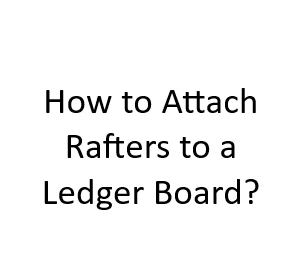When it comes to constructing a sturdy and reliable deck or patio cover, proper attachment of rafters to a ledger board is a crucial step. The ledger board serves as the main support for the entire structure, and the method of attaching rafters to it significantly impacts the stability and safety of the project. In this comprehensive guide, we’ll walk you through the essential steps and considerations to attach rafters to a ledger board, ensuring a durable and well-built outdoor structure.
Step 1: Gather the Necessary Tools and Materials
Before you begin the process of attaching rafters to a ledger board, make sure you have all the required tools and materials on hand. These might include:
- Ledger board
- Rafters
- Joist hangers or rafter connectors
- Lag screws or structural screws
- Drill
- Level
- Measuring tape
- Pencil
- Safety gear (gloves, goggles, etc.)
Step 2: Determine Rafter Spacing and Layout
The spacing between rafters is an essential consideration to ensure the structural integrity of your outdoor cover. The appropriate spacing depends on factors such as the load the structure will bear and the local building codes. Generally, rafters are spaced either 16 or 24 inches apart. Measure and mark the ledger board according to your chosen spacing.
Step 3: Install the Ledger Board
Position the ledger board against the exterior wall where you intend to attach it. Use a level to ensure it’s straight and level. Mark the locations of the attachment points on the ledger board. Pre-drill holes for the lag screws or structural screws, ensuring they penetrate the wall’s framing studs for secure attachment.
Step 4: Attach the Ledger Board
With the holes pre-drilled, attach the ledger board to the wall using lag screws or structural screws. Make sure the ledger board is firmly and securely attached to the wall, as it will bear the weight of the entire structure. Double-check with a level to ensure it’s still straight.
Step 5: Prepare the Rafters
Cut the rafters to the appropriate length based on your project’s dimensions. Ensure that the ends of the rafters are properly squared off for a snug fit against the ledger board and the beam or post on the other side.
Step 6: Install Joist Hangers or Rafter Connectors
To provide additional support and stability, install joist hangers or rafter connectors on the ledger board. These metal brackets will hold the rafters in place securely. Place them at the pre-marked locations corresponding to the rafter spacing. Secure the hangers or connectors to the ledger board using appropriate fasteners.
Step 7: Attach the Rafters
With the joist hangers or rafter connectors in place, carefully position each rafter in its designated space. Slide the ends of the rafters into the hangers or connectors and ensure they are level and plumb. Secure the rafters to the hangers using nails or screws, ensuring a strong connection.
Step 8: Double-Check and Adjust
Once all the rafters are attached, take a moment to double-check their alignment, spacing, and overall stability. Use a level to ensure they are evenly positioned and adjust as needed.
Step 9: Considerations for Different Rafter Attachment Methods
While the basic steps for attaching rafters to a ledger board remain the same, there are a few different methods you can choose from, depending on your specific project and preferences.
- Joist Hangers vs. Rafter Connectors: Joist hangers are commonly used to attach rafters to a ledger board. They provide solid support and help maintain the proper spacing between rafters. Rafter connectors, on the other hand, offer an alternative method and often have a more decorative appearance. Choose the option that aligns with your aesthetic and structural preferences.
- Screws vs. Nails: When attaching rafters to joist hangers or connectors, you have the choice of using screws or nails. Structural screws offer better holding power and are less likely to pull out over time, making them a preferred choice for a longer-lasting attachment.
- Beam Connection: The opposite end of the rafters will be attached to a beam or a supporting post. Depending on the design, you might use traditional notched connections or various hardware connectors to ensure a secure attachment.
- Weather Protection: Since your outdoor structure will be exposed to the elements, consider using weather-resistant materials and protective coatings. Stainless steel screws or galvanized nails can prevent rust and corrosion, prolonging the life of your attachment points.
Step 10: Adhering to Building Codes and Safety
As a responsible builder, it’s crucial to adhere to local building codes and regulations when constructing any outdoor structure. Building codes are in place to ensure the safety and integrity of structures, and they often specify requirements for things like attachment methods, materials, and load-bearing capacities. Consult with your local building department or a professional contractor to ensure your project meets all necessary codes.
Step 11: Regular Maintenance and Inspection
Once your rafters are securely attached to the ledger board, your outdoor structure is well on its way to completion. However, proper maintenance and regular inspection are essential to its long-term durability. Over time, weather, moisture, and general wear and tear can affect the integrity of the attachment points. Regularly inspect the ledger board, rafters, and all connections for signs of damage or deterioration. Address any issues promptly to prevent further problems.
Conclusion
Attaching rafters to a ledger board is a critical step in building a strong and reliable outdoor structure. Whether you’re constructing a deck, patio cover, or pergola, following the proper attachment methods is key to ensuring safety and longevity. By carefully planning the spacing, using appropriate connectors, and adhering to building codes, you can create a functional and beautiful outdoor space that you’ll enjoy for years to come. Remember that safety should always be a top priority, and if you’re unsure about any aspect of the construction process, it’s wise to seek guidance from professionals in the field. With the right techniques and attention to detail, you can successfully attach rafters to a ledger board and create a space that adds value to your home and enhances your outdoor living experience

